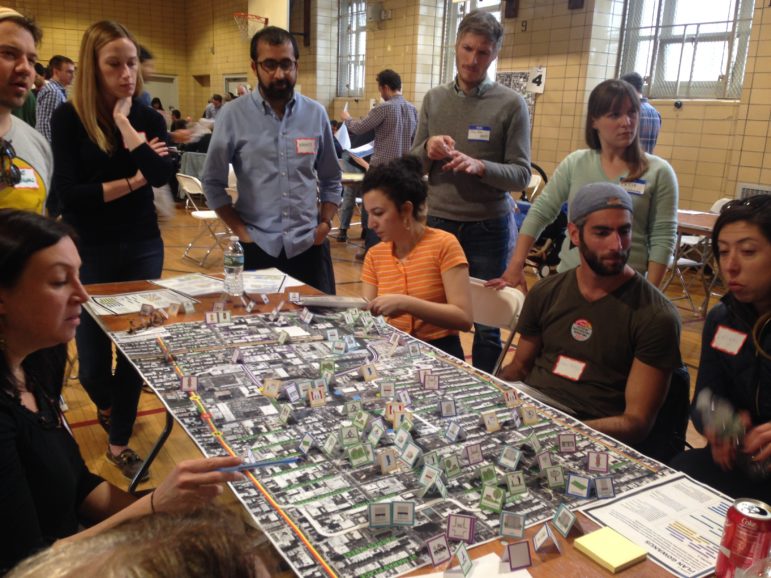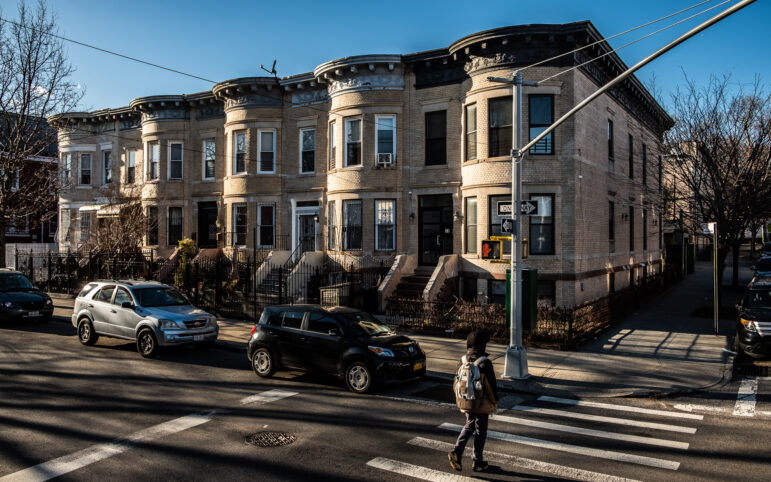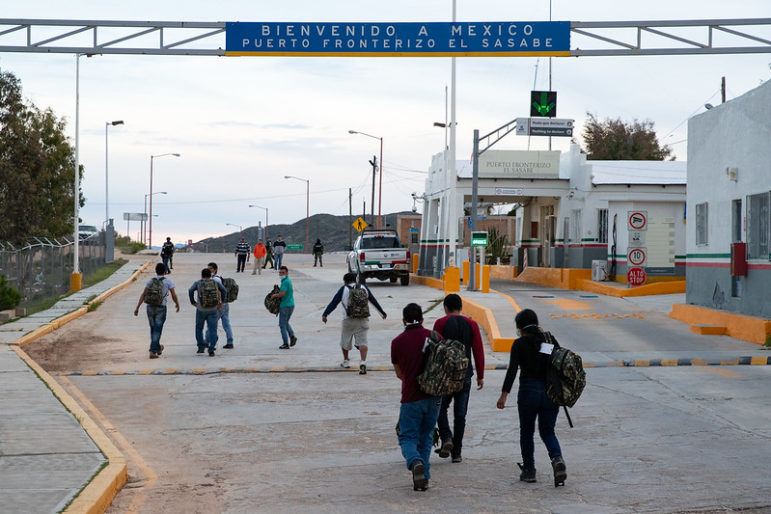
Abigail Savitch-Lew
At the event, participants marked different parcels of land on a map of the neighborhood with the uses they thought would be most appropriate.
At a mapping workshop held Saturday in Gowanus by the Department of City Planning (DCP), some residents asked for more bike lanes, while one expressed concern that bikers whizzing past public housing on their way to downtown don’t always watch out for elderly pedestrians. A local property owner said the canal north of Third Street should offer publicly accessible, walkable green spaces, while a representative for a local manufacturing hub argued the eastern side of the canal north of Third should be reserved for industrial uses. There were debates about whether to allow six-story or 12-story apartment buildings for certain blocks along the canal.
It will eventually be up to DCP to synthesize the many perspectives shared at Saturday’s workshop into a rezoning framework for the neighborhood—and up to Councilmembers Brad Lander and Steven Levin to give the ultimate approval. That rezoning plan will also be informed by the recommendations of five, topic-focused working groups composed of residents and stakeholders that are meeting throughout this spring, as well as the feedback from future workshops and targeted outreach on other subjects like schools, NYCHA and transportation.
There is some fear that certain voices will end up dominating others. Last week a new coalition of groups called the Gowanus Neighborhood Coalition called on the city to take into account the voices of the community’s low-income residents, particularly those in rent-stabilized and public housing. They demanded strong anti-displacement measures for existing tenants and stores, more deeply affordable housing, measures to grow the industrial business sector and encourage employment, and a variety of measures to combat segregation and discrimination.
“I think it’s really important that low-income residents, particularly public housing residents, organize to elevate their voices,” Lander told City Limits at the Saturday workshop.
“The platform they put forward focuses on many of the critical issues here…They align well with both the Bridging Gowanus goals and the [DCP study] goals,” he said, referring first to the neighborhood planning process he facilitated from 2013 to 2015, and second to the de Blasio administration’s study. He added that the coalition places an extra emphasis on justice and equity.
City Limits found that the coalition’s priority platform, Bridging Gowanus and the city’s broad goals for the city do have general overlaps, especially when it comes to coordinating a full cleanup of the canal, supporting resiliency efforts, creating publicly accessible green spaces along the canal, and supporting job-generated activities including the industrial and arts sectors, though of course the city is still short on the details for how they would achieve such goals. Bridging Gowanus and the coalition also call for investments in NYCHA, the passage of anti-harassment policies, and the creation of affordable spaces for artists, small businesses, and community cultural expression. The coalition’s plan is the only one to mention issues like segregation, police harassment, and deeper levels of affordability .
Some of the coalition’s goals also overlap with those created by the five topic-based working groups organized by DCP. The Sustainability and Resiliency working group, for instance, has made it one of their core goals to explore “local emergency preparedness strategies, including options for the long-term management and funding of a preparedness plan”—a specific ask of the coalition. The Housing working group’s top goal is to “craft a preservation strategy for all types of exiting housing,” and also aims to “identify strategies to address NYCHA residents’ needs in their developments and the surrounding neighborhood.” And the Arts and Culture group recognizes the necessity of “affordable space” for the arts and culture community.
The question, of course, is how closely these various groups’ processes will continue to overlaps as goals become translated into specific policies and land use recommendations—and how closely the ultimate rezoning framework and the policy outline created by DCP will reflect the diverse community’s demands.
While the coalition describes displacement as one of the main threats of a rezoning, Lander cautioned against equating Gowanus with a neighborhood like East New York, where discussions were dominated by concerns about the displacement of the majority low-income population (though he also supported the East New York rezoning, which he believed was more productive than taking no action at all).
While he agrees that Gowanus’s remaining low-income tenants in private housing deserve to be protected, he says Gowanus is farther along in the gentrification cycle and that there are very few of them left, that public housing residents are not under threat of displacement, and that most of the Gowanus has long been zoned manufacturing and has no housing anyway. In other words, he stands by the notion that bringing housing—including affordable housing under the city’s new mandatory inclusionary zoning policy—is a recipe for inclusion, not displacement.
According to Bridging Gowanus, there are approximately 1,300 privately owned residential units in the manufacturing-zoned areas around the Gowanus, of which about 200 were rent-regulated (according to a 2010 report), and many of which are in buildings of four stories or less. The report says that these units, built before the 1961 zoning resolution established the area as a manufacturing zone, tend to be more affordable than newer buildings and housing in the adjacent area because of their adjacency to manufacturing uses.
Lander recognized that “the business issues are more complicated”—meaning that local mom-and-pop and manufacturing businesses could be threatened by a rezoning. But he says those businesses are already threatened by competing commercial uses within the manufacturing zone, such as larger self-storage facilities, which critics say provide fewer jobs and pay low wages.
“Doing nothing here, we know what it looks like…a hodgepodge mix of commercial development that [doesn’t do much] either for equity and inclusion, or for neighborhood character.” He says he supports adding density to the Industrial Business Zone, but thinks the area north of Third Street would be better as a mixed-use area with housing and potentially light-manufacturing or artist space on bottom floors.
Coalition members could also be found making their voices heard at the workshop on Saturday. Gowanus Houses poe t Ijaaza El-Nuwaubun, who in the coalition has been an advocate for the preservation of small businesses and support for non-professional artists, praised the mapping activity and said she was excited for the possibility that space along the canal could be used to meet the existing needs of residents for recreational space and grocery stores.
On the other side of the room, the Fifth Avenue Committee’s Sabine Aronowsky, another coalition member, challenged city staffers who spoke of the challenges of regulating the affordability of one-to-three family homes. Aronowsky said it was time to enact a Good Neighbor Tax Credit, a proposal suggested by stakeholders in East New York and other rezoning neighborhoods, which would provide assistance to small homeowners who agree to keep rents low.









One thought on “Gowanus Stakeholders Dig Into Details of Canal’s Future”
Everyone must read this new book! “Zoned Out”
http://www.urpub.org/books/zonedout
Zoned Out! Race, Displacement, and City Planning in New York City
20.00 Editors: Tom Angotti and Sylvia Morse
Contributors: Tom Angotti; Philip DePaolo; Peter Marcuse; Sylvia Morse; Samuel Stein
It is critical to read up on Zoning Laws in NYC if one wants to fight the powers that be!